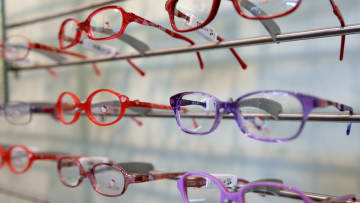دبي، الإمارات العربية المتحدة (CNN) -- في عام 2023، عانى أكثر من ثلث الأطفال حول العالم من قصر النظر . لكن هذه النسبة مرشحة للارتفاع حدّ 40٪ في عام 2050، بحسب ما توصّل إليه بحث جديد نُشر في المجلة البريطانية لطب العيون، الثلاثاء.
يُشير قصر النظر إلى الحالة التي تكون فيها الأشياء الأقرب واضحة، لكن الأشياء البعيدة ضبابية. وبحسب الورقة البحثية، كان هناك ارتفاع كبير في انتشار حالة قصر النظر بين الأطفال والمراهقين في السنوات الثلاثين الماضية، من 24٪ في عام 1990، إلى قرابة 36٪ في عام 2023.
وتوصّل باحثون من جامعة سوت يات-سين في قوانغتشو بالصين إلى نتائجهم هذه من خلال تحليل 276 دراسة شملت أكثر من 5.4 مليون طفل ومراهق، في 50 دولة بالقارات الست.

وبينما كانت هذه الزيادة تدريجية إلى حد كبير، فقد حدثت زيادة ملحوظة بعد جائحة "كوفيد-19"، بحسب الباحثين الذين لحظوا أيضًا التفاوتات الإقليمية.
ووفقًا للورقة البحثية، فقد "برز قصر النظر كمشكلة صحية عامة رئيسية في الوقت الحاضر، مع وجود أدلة على الزيادات السريعة في انتشاره، خصوصًا في دول جنوب شرق آسيا مثل سنغافورة، والصين، وتايوان". وتوصّل البحث إلى أنّ أطفال شرق آسيا سجّلوا أعلى معدل لقصر النظر، بنسبة 35٪، أي أكثر من ضعف معدل أقرانهم من ذوي البشرة البيضاء.
ويقول الباحثون إن مردّ ذلك جزئيًا إلى حقيقة أنّ أطفال شرق آسيا يبدأون التعليم الرسمي في سن 2 أو 3 سنوات، في وقت أبكر مقارنة بالأطفال في مناطق أخرى.
وتصدّرت اليابان القائمة، حيث يعاني 86% من الأطفال هناك من قصر النظر.
وسجلت كوريا الجنوبية ثاني أعلى معدل بنسبة 74%.
وعلى مستوى العالم، يعاني الأطفال في المناطق الحضرية من معدلات قصر النظر أعلى مقارنة بالمناطق الريفية، في حين كانت الإناث أكثر عرضة للإصابة بهذه الحالة من الذكور.
وأكد الباحثون أن الأطفال الأصغر سنًّا كانوا أكثر عرضة للعوامل البيئية من البالغين. وأشاروا إلى أن "هذا مهم بشكل خاص للأطفال في سن ما قبل المدرسة، لأنهم في فترة حرجة من التطور البصري تتميز بالمرونة العالية".
وبالنظر إلى المستقبل، يتوقع الباحثون أن يستمر قصر النظر بتسجيل زيادة بين الأطفال والمراهقين، ليصل إلى 36.6% في عام 2040 و39.8% في عام 2050.
كيف تحمي بصر أطفالك؟
هناك أمور أخرى يمكن للأهل تشجيع أطفالهم على القيام بها لحماية بصرهم، حيث أوصى الباحثون الشباب "بتطوير عادة ممارسة تدابير حماية العين بانتظام".
وأوضح الباحثون أن "على الطلاب أيضا زيادة الوقت الذي يقضونه في النشاط البدني، وتقليل الوقت الذي يقضونه في تشاطات مثل مشاهدة التلفزيون، وألعاب الفيديو، وألعاب الكمبيوتر، وتصفح الإنترنت". كما دعوا المسؤولين إلى تقليل عبء الواجبات المنزلية والدروس الخصوصية على الطلاب، وتعزيز فحوصات العيون، والكشف المبكر، والعلاج.
وقد ردّد الدكتور بنجامين بوتسفورد، طبيب العيون بكلية الطب في جامعة ماساتشوستس تشان، هذه التوصيات بمقال نشره في The Conversation خلال يونيو/ حزيران.
وكتب أنه يمكن إبطاء تقدم قصر النظر عند الأطفال من خلال أخذ فترات راحة، وتجنب استخدام الهاتف أو الكمبيوتر لساعات طويلة.
وأضاف أن الحدّ من وقت القراءة عن قرب خارج المدرسة، ووقت الشاشة، قد يساعد في إبطاء تقدم قصر النظر عند الأطفال.
قاعدة 20-20-20
وقد يؤدي قضاء وقت طويل أمام الشاشة إلى إجهاد العين وجفافها. ويقترح بوتسفورد اتباع "قاعدة 20-20-20"، إذ قال: "خذ فترات راحة لمدة 20 ثانية كل 20 دقيقة للنظر على بعد 20 قدمًا من جهازك. ثمّ ركّز على إرخاء العينين والرمش".
ولفت إلى أن الاستخدام العرضي للدموع الاصطناعية قد يكون مفيدًا، ويمكن شراؤها من دون وصفة طبية من الصيدليات، لعلاج جفاف العين.
ونصح بوتسفورد أيضًا بقضاء الوقت في الهواء الطلق لأنه مفيد لصحة العينين، موضحًا أن "ذلك ارتبط بانخفاض حالات قصر النظر في مرحلة الطفولة".


